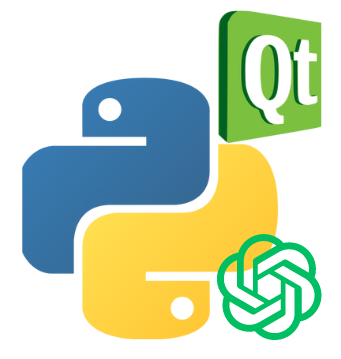Example of using OpenAI with PyQt (Python cross-platform GUI toolkit)
This shows an example of using OpenAI with PyQt as a chatbot and using DALL-E or Stable Diffusion as a image generation tool.
Even though this project has become too huge to be called an 'example'.
The major advantage of this package is that you don't need to know other language aside from Python.
If you want to study openai with Python-only good old desktop software, this is for you.
The OpenAI model this package uses is the gpt-3.5-turbo model(which is nearly as functional as ChatGPT) by default. You can use gpt-4 as well.
Image generation feature(DALL-E and Stable Diffusion) available since v0.1.4.
Stable Diffusion used DreamStudio API. This is not entirely free like stable-diffusion-webgui.
But this is very lightweight and more accessible. don't need CUDA, torch, expansive PC, anything.
This is using sqlite as a database.
You can select the model at the right side bar.
An internet connection is required.
- basically this is desktop application version of ChatGPT with image generation tool
C7E0
.
- text streaming (enable by default, you can disable it)
- AI remembers past conversation
- conversation management
- add & delete conversations
- save conversations
- rename conversation
- everything above is saved in an SQLite database file named conv.db.
- support GPT-4 and every other models below GPT3
- support prompt generator (manageable, autosaved in database)
- support slash commands
- support beginning and ending part of the prompt
- you can run this in background application
- notification will pop up when response is generated
- you can make window stack on top or control its transparency
- image generation (DALL-E, Stable Diffusion with DreamStudio API)
- you can copy and download the image if you want. just hover the mouse cursor over the image.
- qtpy - the package allowing you to write code that works with both PyQt and PySide
- PyQt5 >= 5.14 or PySide6
- openai
- pyperclip - to copy prompt template from prompt generator
- stability_sdk - for Stable Diffusion
 You have to write your openai api key inside the red box. see How to install
You have to write your openai api key inside the red box. see How to install
You can change screen between text chatbot and image generating tool screen.

PyQt.OpenAI.Chatbot.2023-05-06.08-16-48.mp4
2023-05-20.13-50-55.mp4
You can use the additional prompt feature by "prompt menu" right next to input field.
- git clone ~
- cd pyqt-openai
- pip install -r requirements.txt
- python setup.py install
- cd pyqt_openai
- You should put your api key in the line edit. You can get it in official site of openai. Sign up and log in before you get it.
Be sure, this is a very important API key that belongs to you only, so you should remember it and keep it secure.
- python main.py
If installation doesn't work, you can contact me with bring up new issue in issue tab or check the troubleshooting below even it is only about very specific error.
If you use Linux and see this error:
qt.qpa.plugin: could not load the qt platform plugin "xcb" in "" even though it was found
this application failed to start because no qt platform plugin could be initialized, reinstalling the application may fix this problem
run this command:
sudo apt-get install libxcb-xinerama0
If you see this error while installing the openai package
subprocess-exited-with-error
download the package itself from pypi.
Unzip it, access the package directory, type
python setup.py install
That will install the openai.
Note: I don't know this can happen in newer version of openai as well, so tell me if you know about something
You can join pyqt-openai's Discord Server to have a conversation about it or AI-related stuff 🙂
I recommend to install sqlite management software. It's not necessary to run this app (obviously), but it's good practice to manage database about conversation history with AI and to know how this works.
- DB for images (to further experiement of both DALL-E and Stable Diffusion or other image generation engine)
- show the explanation of every model and terms related to AI (e.g. temperature, topp..)
- save conversation history with other format (xlsx, csv, etc.)
- tokenizer
- highlight the source (optional, eventually)
- support multiple language
- use SQLAlchemy (maybe not)
- show reason when the chat input is disabled for some reasons
- add the basic example sources of making deep learning model with PyTorch (eventually)
- Azure OpenAI service
- join gpt4 waitlist - i took 1 month to get access from it
- join chatgpt plugins waitlist


